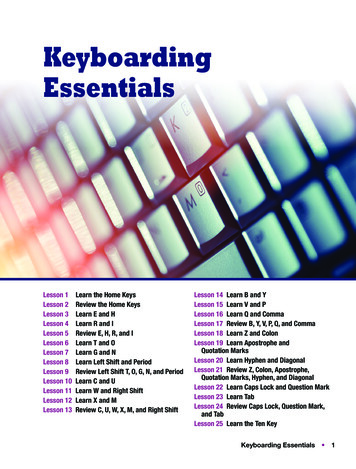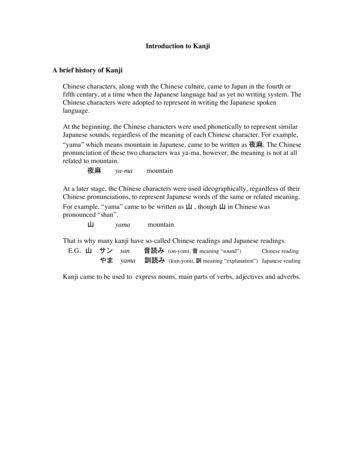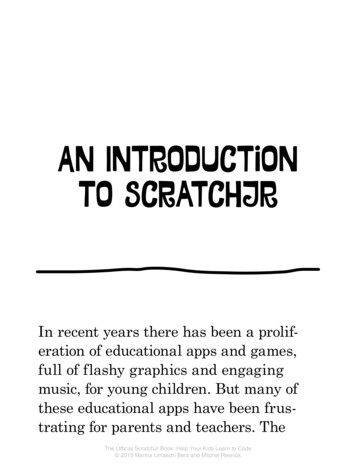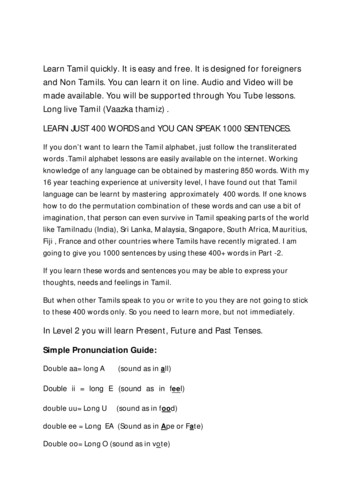
Transcription
1
The Complete Guide To Learn Cantonese 【 廣東話學習指南 】IntroductionLearning any language can be daunting. More so when you're thinking of (or arealready) taking on one of the most difficult languages to learn for English speakers Cantonese. If you've wondered about things like "where should I start", "how do I learnCantonese tones", "should I learn Cantonese characters", you've landed in the rightplace.In this guide, I will show you everything you will need in order to establish an excellentset of fundamentals in Cantonese moving forward. This isn't intended to show you howto get to fluency - but I want to show you the ropes to get your Cantonese to a decentintermediate level. In other words, this is like a road map you can use to "see" clearlywhat things you'll be doing to get to that level.*An important note: Before we start with this guide, please know that what I write hereis not absolute. As a matter of fact, language learning advice has always been, and alwaysremain subjective and varies according to every language learner.But I have, to the best of my ability, attempted to represent each component accurately,in writing, based on my personal experiences learning other languages as well asteaching Cantonese. So I hope you’ll see that I, just like you, am just another learner, andyou can feel free to disagree with any perspectives I have.2
The Complete Guide To Learn Cantonese 【 廣東話學習指南 】That said, there’s a mix of opinionated, and non-opinionated content in here. Forexample, I recommend going through pronunciation first when learning Cantonese(opinionated), but I also put up videos introducing you to the exciting world ofpronunciation (non-opinionated), in hopes you’ll find them useful.I’ll also assume you want to learn Cantonese to speak and communicate to around a B1( B2) level, so this guide is written with that objective in mind.Alright, that’s all I have to say for now, let’s dive right in!3
The Complete Guide To Learn Cantonese 【 廣東話學習指南 】Table of contentsIntroduction2Table of contents4Part 0: 7 Questions To Ask Yourself Before Learning Cantonese8Question 1. Why are you learning Cantonese?8Question 2: To what level do you want to learn Cantonese?11Question 3: What do you plan to do with Cantonese?12Question 4: Do you have enough time to devote to learning Cantonese?13Question 5: Is Cantonese going to be the only foreign language you learn, or is it onein many?14Question 6: Do you speak any Asian languages to a good level of fluency?15Question 7: Are you musical?17Related posts from polyglots18Part 1: How To Sound Like A Native Speaker - Romanization, Jyutping andTonesThe starting point: pronunciationThe importance of pronunciationShadowing your way to pronunciation level fluencyJyutping chartJyutping vs. Yale - Cantonese romanization systemsAn introduction to Cantonese tones and romanizationIntroduction to Cantonese pronunication1919202223242626Part 2: Learn To Speak Cantonese Correctly through StructuresStructures vs. GrammarWhy learn structures at allHow To Learn StructuresCantonese grammar decompositionCantonese grammar resources272728303132Part 3: How To Be More Precise In Cantonese - Learning Words354
The Complete Guide To Learn Cantonese 【 廣東話學習指南 】New Words Via Direct TranslationHow to get to a strong B1 B2 level in CantoneseGrammar as templatesHow To Use A Chinese DictionaryRecommended Chinese dictionariesChecking your translations353740434344Part 4: Learning Chinese Characters - To Do Or Not To Do?The limits of Cantonese romanizationChinese characters - to learn or not to learn?Two Caveats in Learning CharactersReading Chinese vs. writing ChineseSpoken Cantonese vs. written Chinese21 Videos to Help You Get Started with Learning Chinese CharactersLearning the basic radicals and what they meanUnderstanding stroke order to make your handwriting more nativeCopy the 楷體 font in order to neaten up your handwritingHanzicraft to understanding what character components are ( )Recommended frequency listsTools to learn Chinese charactersHow polyglots conquered Chinese characters4545495050525253535454545556Part 5: How To Find The Right Cantonese Teacher For YouWhy I don’t recommend doing “language exchanges”5760Part 6: Finding Inspiration When StuckGetting to a B1 Cantonese levelMy personal thoughts on learning CantoneseInspiration from top experts and polyglotsOn forgetting thingsOn preparation in learning Chinese before speakingOn goal settingOn speaking from day oneOn how to speak a languageOn the importance of the linguistic core656568707171727273735
The Complete Guide To Learn Cantonese 【 廣東話學習指南 】On the notion of difficultyOn getting used to new sounds in a languageOn reasons to learn CantoneseOn learning like a childOn what starting as a stone cold beginner feels likeOn the importance of knowing the whyOn the language learning equationOn independent learningOn language learning obstaclesOn questioning the “follow a course and do as it says” approachOn comparing us to other language learnersOn “talent”On individual workOn perfectionismOn learner’s blockOn celebrating successOn learning by yourselfOn the original purpose of learning languagesOn motivation for learning ChineseOn appreciating foreign scriptsOn inspirationOn the ease and difficulty of every languageOn time, money and abilityOn the objective of a class from a teacher’s perspectiveOn the most important goal of learning a languagePart 7: Cantonese Dictionaries And Typing CantoneseProblems with Typing ChineseUsing a Chinese dictionaryTwo Types of Chinese Dictionaries7 Videos on Cantonese typing and using Chinese dictionariesRecommended Cantonese dictionariesPleco’s ABC Cantonese Dictionary (USD 838384858588929394946
The Complete Guide To Learn Cantonese 【 廣東話學習指南 】Adam Sheik粵典 (jyut6 din2)粵語審音配詞字庫 (jyut6 jyu5 sam2 jam1 pui3 ci4 zi6 fu3)LingueeCharacter to Jyutping converters - to use or not to use?9596969798Cantonese Trivia and FAQ’s1. Where is Cantonese spoken?2. How different are Mandarin and Cantonese?3. What are the differences between written and spoken Cantonese?4. What are Cantonese particles?5. How can I guess the reading of a Chinese character?6. What’s a Chinese character?7. Is there a proficiency exam like the HSK?8. How long will it take me to learn Cantonese?9. Is it possible to learn to speak Cantonese without knowing how to write it?10. How hard is learning Cantonese?11. Should I take classes to learn Cantonese?12. Should I learn Cantonese?13. When should I start to learn Chinese characters?14. Are there some budget ways to learn Cantonese?15. Can Mandarin speakers understand Cantonese? And vice versa?16. Do children in Hong Kong learn Cantonese through romanization?17. Which is harder - Cantonese or Mandarin?18. Are there six, seven or nine tones?19. Is Cantonese a dying language?20. What is CEFR? What are proficiency levels?21. How popular is Cantonese compared to other Asian 15116117117118118120125126Conclusion1287
The Complete Guide To Learn Cantonese 【 廣東話學習指南 】Part 0: 7 Questions To Ask Yourself Before LearningCantoneseLearning Cantonese, or any other language, is a massive undertaking. Before divinginto the actual learning process, I highly recommend asking yourself these sevenquestions to figure out what learning Cantonese means to you. If you take a bit of timeto answer them truthfully and to the best of your ability, one year down the road, you’lllook back thanking yourself for taking this seriously.Here they are.Question 1. Why are you learning Cantonese?Since this is quite a huge commitment, I’ll start off with the most important question.When starting out with the basics, it barely makes a difference whether you knowclearly why you’re learning a language or not. After all, the material is generallystraightforward, learning the pronunciation, basic structures and words, and it could befun going through the basics.But as you continue learning Cantonese, it gets harder. I don’t say this to scare you, thelearner, but I say this because that’s when knowing and not knowing the “why” reallystarts to make a difference - it’ll directly affect whether you’ll be sufficiently motivatedto continue or not.8
The Complete Guide To Learn Cantonese 【 廣東話學習指南 】After the initial honeymoon period wears off with Cantonese, you’ll start to think aboutthings like designing a Cantonese study routine, whether to learn Chinese characters ornot, getting conversational practice with a native. These are all activities that require acertain time commitment and if your reasons are unclear, you’ll find it very hard to pullthrough these tasks.However, I have to insist on pointing out an important distinction: coming up withreasons and coming up with your reasons.If you do a simple Google search, you’ll easily find articles and blog posts that are titled“10 good reasons to still learn Cantonese” or “Top 20 reasons you should learn alanguage”. While we should appreciate these reasons, it’s really important to not mixreasons with personal reasons .In other words, just because, for instance, Cantonese represents quite a large population(around 60 - 100 million speakers), it shouldn’t mean it should become your reason tolearn Cantonese. After all, what has 60 million speakers got to do with you anyway?Compare that with *a student I recently met from Brazil (yup, I teach Cantonese).When I asked him why he wanted to learn Cantonese, he told me that he grew upwatching Cantonese movies and was interested in the culture. During our introductorylesson, I could clearly tell he was extremely careful with his pronunciation(romanization and tones), and he was able to produce these sounds really well.9
The Complete Guide To Learn Cantonese 【 廣東話學習指南 】Whether he did so because he liked Cantonese culture, or just because he’s a detailoriented person, I have no way of knowing. What I can be sure of is that, if he’s willingto go the extra mile to pay attention to these details, this dedication will serve him wellwhen he has to move on to an intermediate stage of learning, and beyond.Or take another student I worked with in the past. She’s American and has a fiancéwho’s from Hong Kong. This means that every time during family reunions with herextended family-in-law, because some members of them don’t speak any English, shecould either not say very much or learn Cantonese to connect with her fiancé’s relatives.Because of a very strong reason to learn the language, she has made remarkable progress(and the credit goes to her, not me or other teachers - she invested a lot of time andeffort to continually expand her vocabulary and consolidate basic structures inCantonese) - in just under two years of study, she already has an excellent B2 level ofability with a wide range of vocabulary and expressions that she could take very easily toa C* level.*Please note that I don’t include students’ names in this guide in order to protect theirprivacy.Question 2: To what level do you want to learn Cantonese?Generally, there are about three “tiers” I divide language learning goals into:Tier 1: The Traveller’s Proficiency ( A1 - B1)10
The Complete Guide To Learn Cantonese 【 廣東話學習指南 】This is where you can pretty much get around town without too much troubleunderstanding or communicating. You can go to restaurants and order menu items,you can shop around, you can understand metro announcements just like how atraveller might want to.Tier 2: The Generalist’s Proficiency ( B2)This is where you have an excellent grasp of the language and you can pretty much talkabout anything you want (save for professional topics), including topics of interest toyou, current affairs in society. You can communicate your thoughts clearly and withoutmuch struggling for words, much like a “generalist”.Tier 3: The Maestro’s Proficiency ( C1 - C2)This is where you’ve pretty much studied in the language, or have listened to or readextensively in the language. You can understand long texts or audio clips and canunderstand the nuances of the content (including cultural references), and you canpretty much follow along without any visible strain.Your vocabulary approaches that of an educated native speaker, and you have noproblem dancing around words and doing all sorts of mental acrobatics when it comesto expressing yourself, including changing your register according to the social context,adopting local accents and using slang, idioms, metaphors accurately and intuitively.11
The Complete Guide To Learn Cantonese 【 廣東話學習指南 】Which of these categories do you fit under?Knowing this can help you figure out what amount of learning is appropriate, andwhen it’s okay to stop and move on from “expansion” to “maintenance”. After all, whilelanguage learning is a lifelong task (even for native speakers), if you have a clear idea ofthe level you want to get to, you simply need to learn up to that level - anything elseshould be counted as bonuses.Question 3: What do you plan to do with Cantonese?Closely related to the previous two questions is - what do you intend to do withCantonese?Do you want to go to Hong Kong or Macau for travel?Do you want to visit a friend in Guangzhou and pick up a few phrases?Do you have a loved one or extended family that speaks Cantonese?Are you going to permanently relocate to Hong Kong and want to better connect withlocals?Whatever your purpose, it’s going to directly affect how you learn Cantonese. As I’llmention below, one of the reasons language learning is so different for everyone isbecause people use it for different things. For instance, a graphics designer is very likely12
The Complete Guide To Learn Cantonese 【 廣東話學習指南 】to have a different vocabulary than a teacher. In the same way, the things you learn willbe directly tied to what you intend to do with the language.Question 4: Do you have enough time to devote to learningCantonese?This is where the second question is important. Depending on the level you want tolearn Cantonese to, the time you need to spend on learning is different. It goes withoutsaying that the higher your desired level, the greater the time commitment. But this hasa few nuances that I want to briefly mention:1. The total time you need to spend learning increases the higher the level youwant;2. The higher the level, the greater the average study time per day;3. The higher the level, the greater the importance of consistent study.So for example, if you’re in a fairly busy profession, and one that has nothing to do withlanguages, maybe you’re an English speaker working as a circuit engineer, and youalready have to devote a lot of time learning about new technologies and attendingtraining classes, it would be difficult to devote a large amount of time to learning alanguage that’s so different from your native language - Cantonese.To top that off, you need to consider that because of time restraints, it will be moredifficult to get your level of Cantonese to a higher level just because you’re strapped for13
The Complete Guide To Learn Cantonese 【 廣東話學習指南 】time. And it will take longer to complete a learning phase where it might have beeneasier for someone who has more time and flexibility on his hands.As I’ll also mention below, I don’t believe it’s necessary to devote hours of learning everyday when it comes to learning a foreign language.However, consistency is important, especially when you’re above an intermediate stage,and if you’re involved in a stressful job where it’s very likely your work will interferewith that consistency (or language learning will interfere with your work), then itmight be wise to consider either taking your expectations down a notch, or Irecommend being honest with yourself when it comes to having enough patience to seethis journey through, or not.Question 5: Is Cantonese going to be the only foreign language youlearn, or is it one in many?This is also related to the previous question. Depending on your profession, it could bequite daunting to learn Cantonese as a language. And if Cantonese is simply a “pitstop”among a long list of languages you intend to “stop by” on top of having to juggle withyour work responsibilities, I’d recommend setting more reasonable expectations interms of linguistic level simply because of the sheer time involved in getting yourlanguage level to a respectable level.However, if it’s going to be your only language of study, or your language set isn’t sodiverse in terms of language families (compare someone who’s aspiring to learn14
The Complete Guide To Learn Cantonese 【 廣東話學習指南 】Cantonese, Icelandic, Russian, Arabic, Korean and Ojibwe to someone who’s aspiringto learn Cantonese, Mandarin and Japanese), then it becomes much more realistic toaim for a very high level.To top that off, knowing two to three languages really well, maybe even to a near nativelevel, is much more achievable than knowing six, seven or more languages equally wellto a near native level.If you have the opportunity to use Cantonese or written Chinese in your studies orwork, it is likely that you’ll also have the opportunity to take your Cantonese to a higherlevel. If, on the other hand, Cantonese is a language you won’t get to use in aprofessional or academic capacity, trying to get to a level where you have the ability toeloquently word your thoughts can take more time.Question 6: Do you speak any Asian languages to a good level offluency?I’ll be more specific here: if you speak Mandarin, Japanese, Korean, Vietnamese - it willbe much faster for you to pick up Cantonese. Not only is there common vocabulary (orthe exact same characters if you already know Mandarin or Japanese), even thepronunciation is similar to a certain extent (Japanese, Korean, and I’ve heardVietnamese is as well). This means that if you know how equivalent words arepronounced, you will be able to learn cognates very quickly.15
The Complete Guide To Learn Cantonese 【 廣東話學習指南 】This also means that your time spent learning will be considerably shortened comparedto learners who do not speak one of these languages. I personally don’t like taking alanguage’s difficulty into consideration (difficulty is relative anyway) when learning,but don’t underestimate the power of having thousands of cognates in the targetlanguage and the languages you already know, and how that affects your 語感 (jyu5gam2, or feel of a language).Consider this - imagine someone who’s going to be learning Cantonese as a languagethat she will rarely use, is very distant to her native culture (as a Spaniard), has nocognates with Spanish, her native language, and has significant cultural differences withher native culture.It’s not too difficult to imagine that she would require double (if not more) the amountof effort needed to learn Cantonese as opposed to another Romance language such asFrench.So if you have an Asian language under your belt, it can be considerably easier to learnCantonese.Question 7: Are you musical?I say this because Cantonese is a tonal language. Unlike most other languages in theworld, every word that you learn in Cantonese will consist of four parts: (1) thecharacters; (2) the romanization; (3) the tones; (4) the meaning. And getting the tones16
The Complete Guide To Learn Cantonese 【 廣東話學習指南 】wrong can sometimes prevent other people from being able to understand youcorrectly.As you’ll see below, characters are not as difficult to learn as some might think;romanization is fairly easy for speakers of most languages; but tones can be challengingif one can’t distinguish between the six tones, because if one can’t hear them, then onesimply can’t reproduce these when speaking.That said, this represents an extreme minority of learners. Everyone, to a certain extent,has musical ability, and the stronger your musical affinity, the better you will fare withtonal languages. So if you’re a musician, you’ll have an advantage here.So these are the seven questions I recommend you consider before taking on thecommitment to learn Cantonese.As a final note in this section, I’d like to say this: please don’t take these as delimitingbeliefs or restraints I’m trying to impose on you. If you feel that you are capable of doingmore, then by all means, please do so!As a teacher of mine used to say, “passion trumps all.” If you love the Cantoneselanguage and culture (include the cuisine!), then any of the above difficulties Imentioned will just feel like a blip along the way.17
The Complete Guide To Learn Cantonese 【 廣東話學習指南 】Just understand that my intentions are to give you a realistic picture of what the journeylooks like in the long term, based on my learning and teaching experiences, with thehopes that this guide will serve as a realistic roadmap for you.Related posts from polyglotsI’ve also curated a few articles written by polyglots broaching the subject, which Ibelieve is one of the most important ones to talk about when learning a new s.com/why-learn-another-language/18
The Complete Guide To Learn Cantonese 【 廣東話學習指南 】Part 1: How To Sound Like A Native Speaker Romanization, Jyutping and TonesThe starting point: pronunciationMy personal belief is that the first thing (technical wise) we need to do when learning anew language is pronunciation. If we don’t understand how the sound system works,our speaking and listening abilities are hindered, and it becomes difficult tocommunicate.There are two parts in Cantonese when it comes to pronunciation: romanization andtones.Fortunately, for English speakers (and possibly for speakers of many other languages),Cantonese is fairly easy to pronounce, because most of the sounds in Cantonese that canbe produced already exist in English.(In contrast, it’s harder for native Cantonese speakers to learn English or otherRomance languages like French or Spanish in terms of the pronunciation.)Tones, however, can be a bit tricky. I won’t talk too much about it here, because I’llembed a few videos where I take you through tones from zero to understanding whattones are fully in a very short timeframe. With a bit of time, though, I’m confident thatany learner can master tones well - after all, there are only six of them!19
The Complete Guide To Learn Cantonese 【 廣東話學習指南 】The importance of pronunciationHere, I’d also like to talk briefly about the importance of pronunciation.One question that language learners ask, when it comes to pronunciation, is, “howimportant is pronunciation?”Different people have different answers.For example, in university, I considered switching majors to a language major, and theadmissions officer who was in charge of administration told me that “the languagedepartment will have to test you before admitting you to the program - after all, if youcan’t replicate these sounds, you can’t speak the language.”The undertones of what the person said was, “if you’re incapable of uttering thelanguage like a native speaker, don’t even think about getting into the department.” Asit’s academia, I can understand the standards observed there.However, I disagree.My principle when it comes to pronunciation is simple: “learn it to the extent you canmake yourself understood.” If you can communicate, it’s good enough. Any work youadd on top of that will be a huge bonus that native speakers will surely come toappreciate.20
The Complete Guide To Learn Cantonese 【 廣東話學習指南 】What this means is that, if one’s speaks with an accent so thick, or one’s pronunciationis so inaccurate to the extent that native speakers, even particularly patient ones, havetrouble with understanding, then the learner might need to put in more effort inpronunciation.Based on the fact that Cantonese is a fairly pronounceable language, I would hazard aguess that very few learners would find themselves there.That said, we shouldn’t underestimate the power of good pronunciation.The initial stage of learning a language is communication. And that’s one of the mostimportant functions of languages - to communicate.But once we’ve gone past that stage, we want to delve deeper, and be more precise withour word usage, grammar, and so forth. And it only stands to reason that our accentshould accurately reflect the increased depth in our knowledge.At the higher levels of language learning, I feel having a decent accent becomes moreimportant. Even if someone were to be very eloquent, a strong accent can give the falseimpression that the person is not as accomplished in that language, which is a shame.In the case of Cantonese, as we have here, the significance is twofold: firstly, that everysingle syllable be uttered correctly and secondly, that each word’s tone be on pitch.21
The Complete Guide To Learn Cantonese 【 廣東話學習指南 】So while we shouldn’t put too much stock in the belief that “pronunciation can make orbreak a person’s language abilities”, we shouldn’t underestimate it either, particularly atthe higher levels.Shadowing your way to pronunciation level fluencyIn my personal opinion, I believe that pronunciation isn’t a one off learning project - i.e.it isn’t a “you get it right once, and you’ll get it right forever” kind of thing. I believe thatpronunciation practice comes in stages:Stage I: Pronunciation of individual soundsStage II: Pronunciation of words and short phrasesStage III: Intonation and stress of entire sentencesStage IV: Changing registersHowever, as you can imagine, we don’t move through each stage in a straight line - wehave to keep on revisiting pronunciation at each stage.To top that off, the higher stages aren’t possible without a sufficient vocabulary and acertain degree of fluency.One method that’s commonly talked about in the world of pronunciation is shadowing.22
The Complete Guide To Learn Cantonese 【 廣東話學習指南 】In a nutshell, shadowing is a fancy way of saying “copying how native speakers speak”.And it means that in a very literal sense - you literally copy word after word, or at ahigher level, phrase after phrase after the native speaker. As you can imagine, you’llneed a relatively large body of audio or video material to work with.Here’s an example of how shadowing would work in Cantonese:https://www.youtube.com/watch?v UsN0B9-pYGA&list PLkZ9VSSGnc6hIWxcG2t1r7FFvziH7Z R5Jyutping chartAnother thing that makes pronunciation in Cantonese a breeze for foreigners is that theway that Cantonese sounds are constructed makes it possible to map all (that’s right, youheard right), all the possible combinations of sounds in a chart.And as it so happens, I’ve created one here at Cantolounge that you can visit //youtu.be/BkjXYgRSxwg23
The Complete Guide To Learn Cantonese 【 廣東話學習指南 】(Please note that this chart isn’t optimized for mobile viewing (there’s a slight bug thataffects how the chart displays on iOS devices). I apologize for the inconvenience, but inthe meanwhile, please consider visiting this chart with a desktop browser.)I’ve also detailed how you can use this guide over here, so you can reference it and getsome ideas as to how it’s made, when it could be useful to revisit this chart, and how touse tes/Jyutping vs. Yale - Cantonese romanization systemsAs you learn Cantonese, one peculiarity you’ll discover is that unlike its close cousin,Mandarin, it has no official romanization system.The most popular romanization systems include Jyutping, Yale and the Sidney Lausystems, however, some authors decide to make up their own systems, and the HongKong government uses yet another variation of romanization (this system anglicizesCantonese words so they’re easier to pronounce for foreigners during the Britishcolonial times).As an example let’s compare how the place name “ 灣仔 ” (a place name in Hong Kong)would be written in these systems.Jyutping: waan1 zai224
The Complete Guide To Learn Cantonese 【 廣東話學習指南 】Yale: wāan jáiSidney Lau: waan1 jai2HK government: wan chaiRegardless of which system is used (the HK government system doesn’t really count,because it’s not a representation, but an anglicized approximation of the actual sound),it’s important to remember one thing: it’s only a representation of the actual sound .While many of these romanizations are so close to English sounds you can treat them asstrange looking English words, some of them are simply approximations - I highlyencourage you to refer to the Jyutping chart I’ve linked to earlier to reference how thesesounds are pronounced by native speakers (1500 recordings).Nowadays, the most popular systems in use are Jyutping and Yale. While you mightfind many older textbooks using Yale, more publications are adopting Jyutping as the defacto romanization system.Unfortunately, this means that you’ll have to get used to both systems - the Cantoneselearning materials that you will come across will likely use either. The good news is thatthe switch is fairly easy and intuitive, so it’s very little effort on your part.By the way, at Cantolounge, we use Jyutping exclusively.25
The Complete Guide To Learn Cantonese 【 廣東話學習指南 】An introduction to Cantonese tones and romanizationI’ve embedded 8 videos I’ve created to introduce you to tones. Hopefully, this will serveas a gentle, but comprehensive introduction to romanization and how Cantonese toneswork.Introduction to Cantonese pronunicationhttps://www.youtube.com/watch?v pF5MYtRFkrg&list PLkZ9VSSGnc6g9g-v5cw8Ng5Co8gJBbS9uUseful resources九聲六調 : https://www.youtube.com/watch?v Uo5lJlBnzAgLanguage is music https://www.youtube.com/watch?v eFpzeGoP-Kg26
The Complete Guide To Learn Cantonese 【 廣東話學習指南 】Part 2: Learn To Speak Cantonese Correctly thr
15. Can Mandarin speakers understand Cantonese? And vice versa? 117 16. Do children in Hong Kong learn Cantonese through romanization? 117 17. Which is harder - Cantonese or Mandarin?











